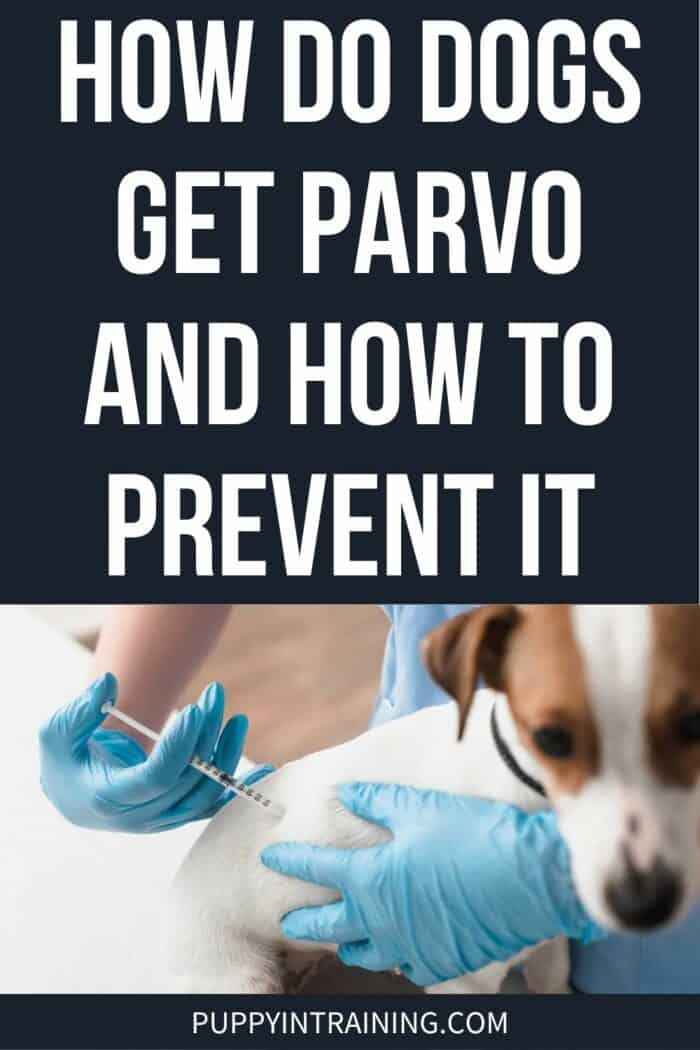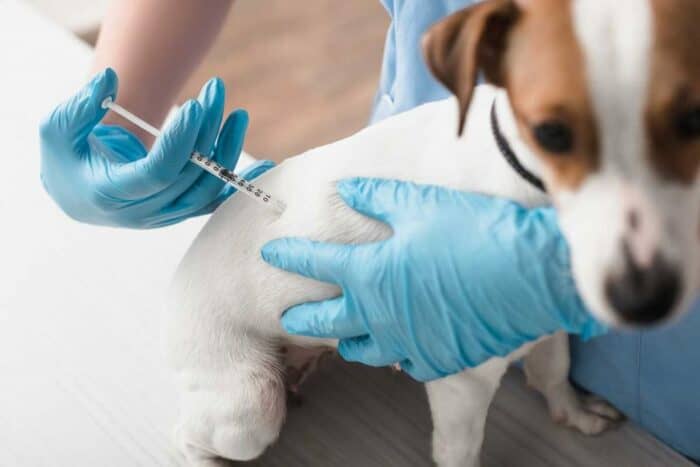How Do Dogs Get Parvo & How To Prevent It
This post may contain affiliate links. We may earn money or products from the companies mentioned in this post.
Parvo is one of the most terrible diseases that puppies can get.
It is highly contagious, so puppies are at a high risk of contracting it before they are vaccinated. It can also quickly become fatal.
Read on as I take a closer look at exactly what parvo is, how and when your dog is likely to catch parvo, and how you can best prevent it.
Also, if your dog catches parvo, don’t panic–I will discuss what you can expect from the recovery process and how to get your dog back to their usual healthy self.
What Is Parvo?
Parvo is the short name for canine parvovirus, a highly contagious infection among unvaccinated dogs.
This disease mainly attacks an affected dog’s stomach and small intestines. From there, it destroys cells, impairs nutrient absorption, and disrupts the gut barrier.
In bad cases, the disease can affect your dog’s bone marrow and lymphopoietic tissues. In the most severe cases, the disease can even spread to the heart and cause death.
Symptoms can take up to a week to present in infected puppies.
The symptoms are varied and generally quite serious, including bloody diarrhea, vomiting, fever, lethargy, loss of appetite, weight loss, dehydration, and depression.
All of these symptoms weaken your puppy’s immune system and make them more susceptible to other illnesses, which they are then unable to fight off naturally.
How Do Dogs Catch Parvo?
Parvo is extremely contagious and spreads in much the same way as the Coronavirus.
Puppies can catch the disease through direct contact with infected dogs and secondary contact with contaminated surfaces.
They shed the disease with their hair and skin cells, and it is most prevalent in their feces and urine.
Puppies and dogs that catch the disease start shedding the contagious virus within four to five days, which may be before they begin to show symptoms.
This is the most dangerous time for passing the disease to other dogs. They can continue to be contagious even ten days after they have made a clinical recovery.
The shed virus can survive independently on surfaces indoors for up to a month and for much longer outdoors depending on the conditions.
You can try and reduce the spread of the virus with a special Parvo disinfectant to remove the contagious material from all surfaces.
How To Prevent Parvo
The best way to prevent your puppy or dog from catching parvovirus is to simply vaccinate them against the disease as soon as possible.
Young puppies on mother’s milk get immunity from their mothers, but they lose this quickly once they stop suckling from their mother.
The parvo vaccine comes in multiple doses, and your dog will need at least four.
They can have their first dose as young as six weeks, and they should receive their final dose at 14 to 16 weeks.
They will then need booster doses every one to three years. Your puppy is still vulnerable in the early weeks while waiting for their 14-to-16-week dose.
During these formative weeks, it is important to keep your puppy away from dogs that have not been vaccinated for parvo.
This is one of the main reasons why young puppies are not allowed to visit dog parks, as they have a high risk for both catching and spreading parvo.
Read our guide to puppy vaccinations.
What If Your Dog Gets Parvo?
What should you do if, despite your best efforts, your puppy gets parvo? The first thing to do is make an emergency appointment with your vet.
Make sure to tell them your suspicions when making an appointment, as they will need to arrange to admit your puppy in quarantine circumstances to avoid further spread of the disease.
Your vet will probably be able to make the diagnosis based on clinical signs, but they may also conduct an ELISA test on your dog’s feces to detect the virus antigens.
There is no treatment for parvo, but your vet can help keep your dog as healthy as possible so they are better able to fight off the disease and any other infections they become susceptible to with their weakened immune system.
This mostly means keeping your dog hydrated and ensuring they are getting the nutrients they need, which they are likely rapidly losing through vomiting and diarrhea.
Parvo can be fatal, but with the assistance of a vet, dogs have a 70 to 90% survival rate.
Early treatment is vital, as many dogs who die from parvo succumb to the disease within just three to four days.
After this time, they are very likely to make a full recovery within a week.
FAQs About Parvovirus
How easy is it for dogs to get parvo?
Parvo is highly contagious, and it can be caught through direct contact with infected dogs and secondary contact with infected surfaces.
The virus can survive on surfaces for more than a month, and infected dogs start shedding before they show symptoms and for a good ten days after they have made a clinical recovery.
What are the first signs of parvo in a dog?
The very first signs of parvo in dogs tend to be fever and lethargy, plus a loss of appetite, which often leads to rapid weight loss.
These signs will soon be followed by vomiting and diarrhea, often with blood present.
Can dogs get parvo from grass?
Parvo is highly resilient and can survive on most surfaces, including grass.
If you walk on contaminated grass, you can also bring the virus into your home on the bottom of your feet or shoes.
When your dog is in the puppy stage, be very mindful of what contaminants you could be bringing into your home.
Can adult dogs get parvo?
Adult dogs that have been vaccinated for parvo can still pick up the disease.
While they will probably not show any symptoms, they can spread the virus through their shedding and feces.
If you have an older dog and a puppy that is not yet vaccinated for parvo, your older dog may need to skip the dog park for a while to avoid picking up the disease and bringing it home.
At what age are dogs likely to get parvo?
Dogs are most at risk of catching parvo between about six and 12 weeks of age.
At six weeks, they stop relying so much on mother’s milk, which gives them natural protection against the virus.
They will only complete their full parvo vaccination at 12 to 14 weeks, and they are at risk until this time.
What kills parvo in the yard?
While bleach kills parvo in the home, you will need to choose a disinfectant for organic material in the yard, such as AHP or potassium peroxymonosulfate.
Clean your glass with water and allow it to dry completely before applying the cleaner.
Remember that these chemicals can be dangerous for your dog as well, so they will have to be kept out of the yard for a little while.
Can a fully vaccinated dog get parvo?
While fully vaccinated dogs receive good protection from parvo, no vaccine is 100% effective.
Even if your dog is vaccinated, they can still catch the disease and pass it to other dogs.
Fortunately, their vaccination will ensure the symptoms are mild and not life threatening.
Can humans catch parvo?
There is a human strain of parvo, but it is different from the type of parvo that dogs get.
Humans cannot catch parvo from dogs, and dogs will also not catch the human (B19) variation of parvo.
What does a dog’s poop look like with parvo?
Puppies often develop vomiting and diarrhea symptoms when they get parvo. Their vomit can be clear, yellow, or brown in color.
Their diarrhea will probably contain blood and have a mustard yellow hue.
What areas are high risk for parvo?
Parvo is most contagious in areas where there are lots of dogs, as there is a greater likelihood of unvaccinated dogs, and the virus will be more concentrated.
This is why puppies should not be taken to dog parks or kennels until they are fully vaccinated.
Can parvo be cured?
There is no cure for parvo, but your dog can fight the virus off themselves if they have the strength.
This means it is important to bolster them with hydration and nutrients they are losing through vomiting and diarrhea.
If your puppy has the strength, they should be able to fight the virus off within about a week of presenting symptoms.
Avoiding Canine Parvo
Parvo is one of the most serious diseases that puppies can catch before they are vaccinated. It is highly contagious and can be fatal.
There is no treatment, but your puppy can fight off the disease themselves if they can be kept strong enough.
Symptoms to look out for include:
- Vomiting and diarrhea
- Fever
- Lethargic behavior
- Loss of appetite
- Weight loss
- Dehydration
Puppies need several parvo vaccinations until they are 14 to 16 weeks old, but they are still vulnerable during the vaccination process.
Remember, they also need a booster shot every one to three years, and it is included in the DCPP shot.
Save To Pinterest

Top Picks For Our Puppies
- BEST DOG CHEW
We Like: Beef Collagen Sticks - All of our pups love to bite, nip, and chew. We love using Collagen Sticks to help divert these unwanted behaviors. - BEST PUPPY TOY
We Like: Calmeroos Puppy Toy w/ Heartbeat and Heat Packs - Perfect for new puppies. Helps ease anxiety in their new home. - BEST DOG TREATS
We Like: Crazy Dog Train-Me Treats - We use these as our high-value treats for our guide dog puppies. - BEST FRESH DOG FOOD
We Like: The Farmer's Dog - A couple months ago we started feeding Raven fresh dog food and she loves it! Get 50% off your first order of The Farmer's Dog.
Check out more of our favorites on our New Puppy Checklist.
